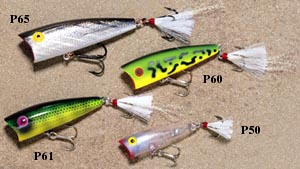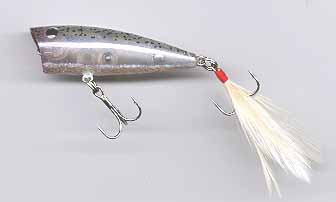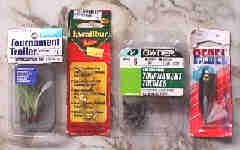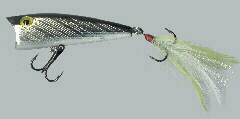|
|
Making The Most of A Pop-R
(and its clones)
by Ken Cook
|
|
 The
venerable Rebel Pop-R is one of the most popular topwaters made.
The Pop-R is manufactured in 50 (2"), 60 (2 1/2") and 65 (3") series. PRADCO
added the longer Pro series as well, with the length of the 65 and packing #4
Excalibur hooks, but a diameter closer to the 60 series.
The
venerable Rebel Pop-R is one of the most popular topwaters made.
The Pop-R is manufactured in 50 (2"), 60 (2 1/2") and 65 (3") series. PRADCO
added the longer Pro series as well, with the length of the 65 and packing #4
Excalibur hooks, but a diameter closer to the 60 series.
Specialty companies both here and abroad have copied
and "improved" the design and many swear by these custom (and often expensive)
variations. The bottom line is still to match the overall size and action
of the bait to what the fish want, but there are a few items that can be
addressed to improve the odds.
The Bait: Although other
colors and sizes produce better at times, the standard Chrome/Black back
60 series is my "go to", followed by Clear and Baby Bass.
Front Hook: The Pro
series Pop-R and high end clones come with high quality hooks, but the
basic Pop-R is still produced with marginal hooks. Replacing "stock" hooks
with Excalibur, Owner, VMC or other high quality hooks (#6 for 60 series,
#4 for 65 series) is a must to achieve a high strike/hookup/landing ratio.
I use both the Excalibur (XTE6) and Owner Tournament Treble (5321).
Rear Hook: This is the key to
more strikes and hookups! Again, the "stock" rear hook and dressing (see
picture above) leave much to be desired. The size, color, type and, above all,
length of the dressing make a significant difference in improving success. Although
many dressing colors and feather/mylar combinations are available, I generally
"stick with the basics": a chartreuse and white feather combination with a few
strands of mylar for flash. The dressing should be 2" or longer for the 60 series.
For my "customized" Pop-Rs, I prefer the Owner Tournament Trailer (5165-051-03).
VMC makes a good one as well. No matter which product you choose or, if you
decide to build your own, apply a couple of (extra) coats of clear fingernail
polish to the tying threads to increase durability.
The "off the
shelf" Custom baits, such as SOB's Lil' Pop and
Don Iovino's
Splash It typically have this type long feathered dressing.
At right, the required hardware
and a shot of a modified Pop-R:
|
|
|
|
|
|
|
|
If you are really
in to modifying baits, you can try cutting the lip to change the "popping"
characteristics. "Spitting", "splashing" and "jumping" can be achieved
with the right changes in the lip(s). Good with an airbrush? A custom paint
job or simply adding an orange belly can often achieve results when the
"standard colors" aren't working. I'll leave those mods up to you.
Modifying the bait is
only the first part. There are many ways to fish a topwater bait and it's
not all technique.
Tackle can be
as important as the bait itself. Bucking the trend to return to glass for
hard (treble hook) baits, I still prefer a carefully chosen 6'6" medium
action graphite rod. Brand and cost (you wouldn't believe what I use) are
irrelevant. Proper rod action when working the bait, setting the hook and
bringing the fish to the boat are what count. For best bait control and
action, I direct tie to the bait using a Palomar knot, choosing 12-15 pound
monofilament line for most conditions and generally reserving heavier line
for larger baits like the Spook. Lighter line will increase both casting
range and accuracy and can result in more strikes. Line stretch,
combined with the right rod action and drag setting, allows a good hookset
without pulling free and helps in fighting the fish to the boat, especially
when they make that frantic last second run.
Although I use braid (Lynch Line) for most soft
bait applications, I prefer the stretch of mono when using hard baits.
Braid (or any of the other low stretch "super lines") will work, but requires
a lighter drag and/or softer rod action to prevent pullouts on the hookset
or while fighting the fish. A topwater bait also tends to "overrun" the
line and tangle the front hook when using a superline. This can be prevented
by using a short (6-12") mono shock leader, but joining the superline and
mono without using a swivel (which could kill the bait's action) is a serious
challenge.
Techniques vary widely
and it is ultimately the fish that dictate which to use, but I achieve
my most consistent results by working the bait slowly, using soft pops
and relatively long delays between. How long between pops (or "twitches")
and how many? Only the fish can tell you that. The rear hook dressing is
a major part of the success of this technique. Even when the bait is at
rest, the long feathers are in constant, tantalizing motion. This technique
works well in open water, but is at its best when targeting specific spots
such as a grass edge, submerged brush or treetops, retaining walls or rip-rap
and boat docks. As fish susceptable to topwaters are often spooky or finicky,
I also prefer to make relatively long casts. Accuracy and delivery can
be everything in this situation. Too close or too noisy on the delivery
can spook the fish and, conversely, too far away and you can't get their
attention.
Any discussion of topwater
fishing must cover the hookset. Nothing has changed. You should wait until
you feel the fish, but it's awfully hard to do when you see that blowup
or boil and the bait just "disappears".
Good luck on your next outing!
-30-
Copyright © 2000-2025
Ken Cook, all rights reserved
 The
venerable Rebel Pop-R is one of the most popular topwaters made.
The Pop-R is manufactured in 50 (2"), 60 (2 1/2") and 65 (3") series. PRADCO
added the longer Pro series as well, with the length of the 65 and packing #4
Excalibur hooks, but a diameter closer to the 60 series.
The
venerable Rebel Pop-R is one of the most popular topwaters made.
The Pop-R is manufactured in 50 (2"), 60 (2 1/2") and 65 (3") series. PRADCO
added the longer Pro series as well, with the length of the 65 and packing #4
Excalibur hooks, but a diameter closer to the 60 series. 


